Immerse yourself in the journeys of biblical cohorts, where unity and faith intertwine, revealing timeless lessons and mysteries yet to be uncovered.
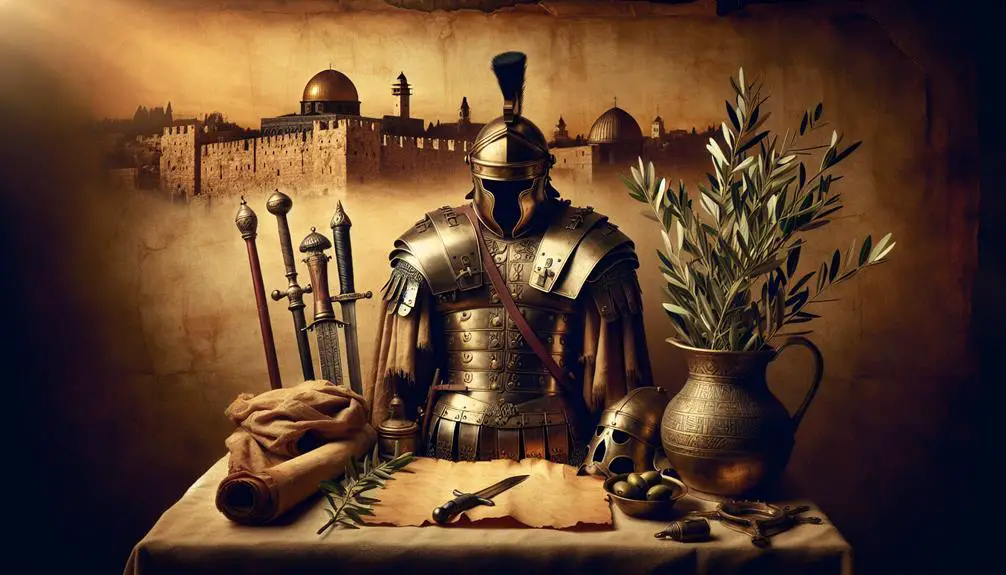
Cohorts in the Bible
In the Bible, you'll notice that leaders rise and fall, nations come and go, but it's the cohorts behind them—be it the Twelve Tribes of Israel, Jesus' disciples, or the early Christian church—that truly shape the narrative.
As you explore these groups, you'll find their dynamics, faith, and challenges not only fascinating but also incredibly relevant to understanding the broader biblical stories. What binds these diverse cohorts together, and how do their journeys reflect larger themes in scripture?
This question hangs in the balance, inviting you to explore further and uncover the profound connections that resonate through time.
Key Takeaways
- Cohorts, such as disciples and tribal groups, played pivotal roles in biblical narratives and religious practices.
- They facilitated the dissemination and interpretation of divine messages, enhancing community spiritual growth.
- These groups contributed to shaping the social and ethical frameworks within biblical communities.
- Their existence and actions underscored the importance of collective faith and community cohesion in biblical times.
The Twelve Tribes of Israel
Delving into the Twelve Tribes of Israel, we find them central to understanding the socio-political and religious landscape of the biblical narrative, each tribe originating from one of Jacob's twelve sons and playing a distinct role in the history and development of the Israelite people. The tribal symbols, deeply emblematic, aren't just ornamental but carry profound meanings, reflecting each tribe's identity and destiny. For instance, Judah is represented by a lion, symbolizing strength and leadership, a prophecy of the tribe's kingly lineage, including David and, by Christian interpretation, Jesus Christ.
Land allotments, too, were more than mere real estate transactions; they were divine distributions reflecting the tribes' roles and relationships. After the Exodus, the land of Canaan was divided among the tribes (excluding Levi, who were given no land but cities of refuge, and Joseph, whose two sons Ephraim and Manasseh, received separate portions). These allotments weren't only practical, ensuring each tribe's sustenance and survival, but also symbolic, embodying promises made to Abraham and his descendants.
Analyzing these elements, you grasp the complexity of Israel's tribal society. The symbols and land allotments intertwine, narrating a story of divine promise, human struggle, and eventual settlement in a land flowing with milk and honey. Each tribe's unique symbol and allotted territory are testament to their individual and collective identities within the broader narrative of the Israelite people, offering insights into their socio-political structures, religious practices, and cultural ethos.
Disciples of Jesus Christ
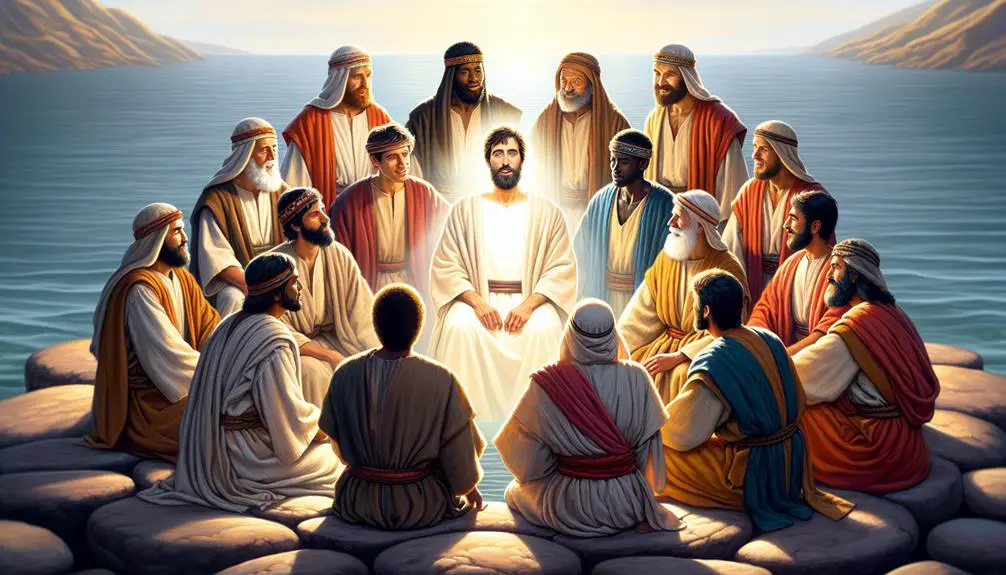
Transitioning from the historical intricacies of the Twelve Tribes of Israel, we now turn our focus to Jesus Christ's disciples, a group integral to the foundational narrative and doctrinal development of early Christianity. The disciples weren't just followers; they were the cornerstone of what would become a global faith, tasked with spreading Jesus's teachings far beyond their initial geographical confines.
You'll find that their roles were multifaceted, encompassing both spiritual guidance and the practical execution of Apostolic missions. These missions were pivotal in establishing the early church's reach, setting the groundwork for a religion that would eventually span continents.
Interestingly, the composition of this group also hints at the diverse backgrounds from which they came, including Zealot affiliations, which suggests a complex interplay of political and religious ideologies within the inner circle of Jesus. This diversity didn't weaken their cause; rather, it enriched the tapestry of perspectives and strategies employed in their collective mission.
To paint a clearer picture, consider the following aspects:
- Apostolic Missions: Encompassing both evangelistic outreach and the establishment of early Christian communities.
- Zealot Affiliations: Reflecting the socio-political diversity within the group and hinting at a broader spectrum of early Christian thought.
- Foundational Narrative: Their stories and actions are central to the gospels, providing both a historical account and a theological framework for Christianity.
Through their teachings, travels, and trials, the disciples of Jesus Christ played a crucial role in the spread and establishment of Christianity, demonstrating the power of faith united with purposeful action.
Followers of Moses
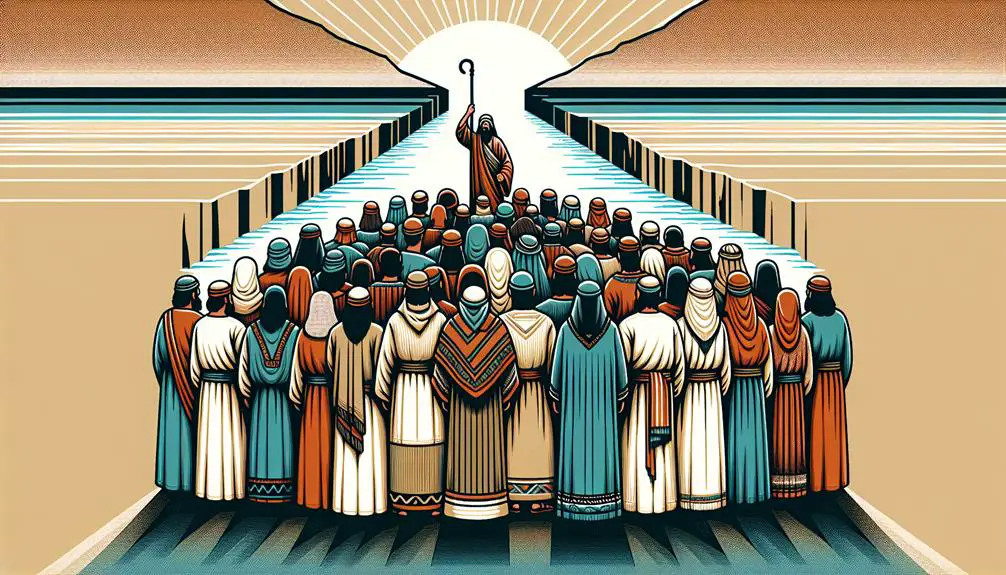
Shifting our focus to the era of the Exodus, the followers of Moses represent a pivotal group in the narrative of the Hebrew Bible, embodying the transition from bondage to covenantal faith. This cohort, comprised initially of the Israelites enslaved in Egypt, becomes a distinct community under Moses's leadership, navigating the challenges and revelations of their desert wanderings.
You'll observe that their journey isn't merely a physical relocation but a profound transformation of identity and faith. The desert wanderings serve as both a literal and metaphorical backdrop for this evolution, marked by trials, moments of doubt, and, crucially, miraculous provisions. These provisions, ranging from manna from heaven to water from a rock, aren't just acts of survival but are emblematic of a deeper covenantal relationship being forged between the divine and the followers of Moses.
Analyzing their journey, you'll notice that it's punctuated by significant events that test and ultimately strengthen their faith. The giving of the Law at Sinai, for instance, isn't just a legalistic event but a foundational moment of communal identity formation. It's in these contexts that the followers of Moses are transformed from a disparate group of escaped slaves into a cohesive nation bound by shared beliefs and divine laws.
Understanding the followers of Moses, therefore, requires you to appreciate not just their physical journey through the desert but the spiritual maturation that occurs within this harsh, demanding landscape. Their story exemplifies the complex interplay between faith, leadership, and community under the most challenging circumstances, underscored by miraculous provisions that sustain both body and spirit.
The Early Christian Church
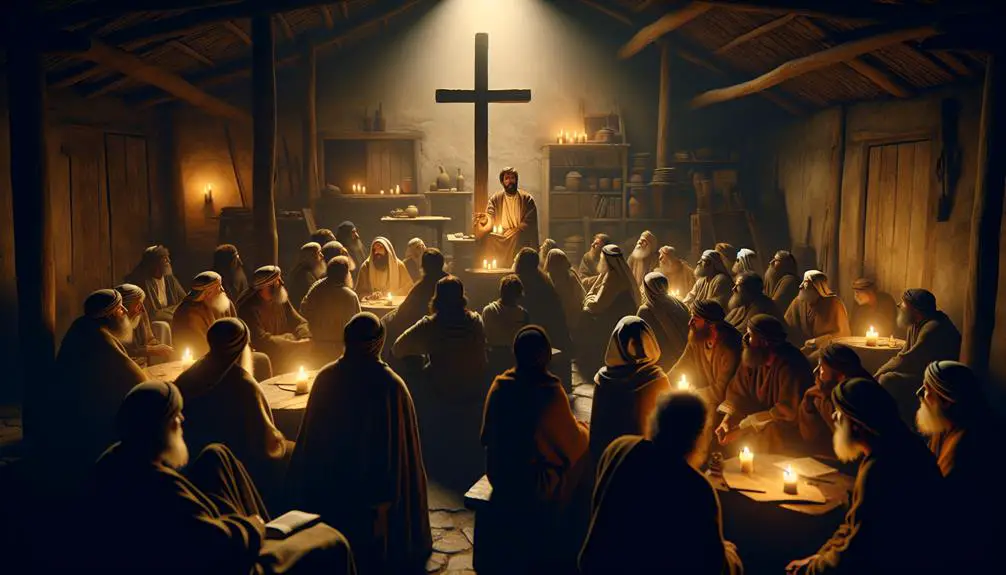
Exploring the narrative arc from the Hebrew Bible to the New Testament, we encounter the formative period of the Early Christian Church, a crucial phase marked by its rapid expansion and the challenges of defining a communal identity amidst diverse beliefs. This era, pivotal in the history of Christianity, was characterized by significant developments including Gentile inclusion and the establishment of an ecclesiastical structure.
- *Gentile inclusion*: The early Church grappled with the question of whether Gentiles, or non-Jews, could be part of the Christian community without adhering to traditional Jewish laws. This inclusivity was a radical shift, emphasizing faith in Jesus Christ as the cornerstone of belonging rather than ethnic lineage or adherence to the Mosaic Law.
- *Ecclesiastical structure*: As the Church grew, so did the need for an organized structure. The apostles and early church leaders established roles such as bishops, deacons, and elders to oversee the spiritual and administrative needs of the community. This hierarchy aimed to maintain doctrinal purity and unity among the believers.
- *Community identity*: Amidst internal and external pressures, the Early Christian Church sought to define its identity. This period saw the penning of key doctrinal texts and creeds that aimed to unify the diverse beliefs within the community and distinguish it from both Judaism and the pagan religions of the Roman Empire.
Analyzing these dynamics, you gain insight into how the Early Christian Church navigated its foundational challenges, laying the groundwork for Christianity's global spread.
Prophets and Their Circles
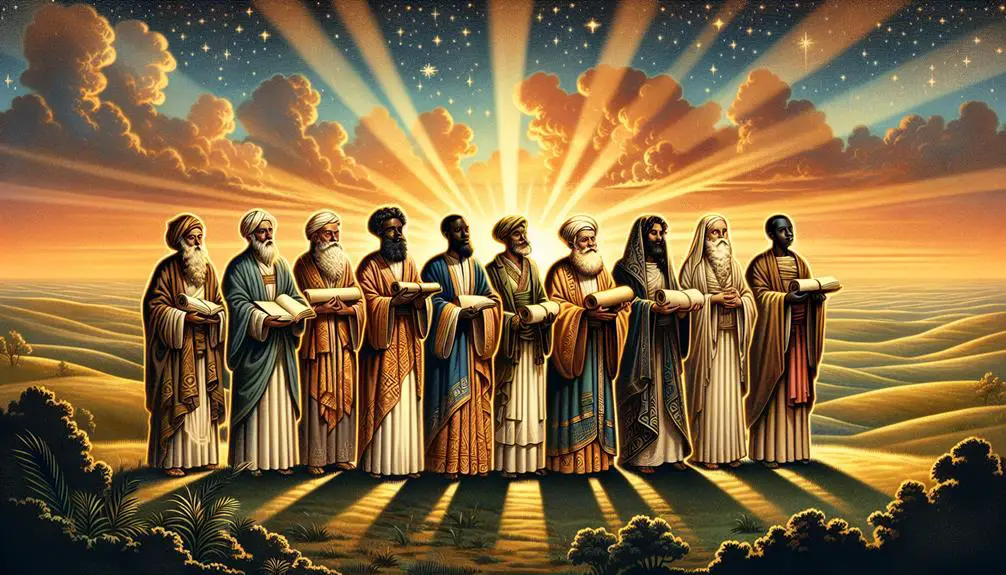
Within the diverse tapestry of Biblical narratives, prophets and their cohorts emerge as pivotal figures, orchestrating a dialogue between the divine and the human communities they served. These groups, often formed around a central prophetic figure, played a crucial role in disseminating prophetic visions and ensuring that divine mandates were both understood and acted upon within their wider community contexts.
You delve into the nature of these prophetic circles, you'll find that they weren't merely passive recipients of divine messages. Instead, they actively engaged with these revelations, interpreting and adapting them to the needs and circumstances of their times. This dynamic interaction underscores the significance of the collective over the individual, highlighting how the prophets and their cohorts functioned as a bridge between the transcendental and the earthly realms.
Moreover, the composition of these groups was far from uniform. They could include disciples, fellow prophets, or even broader segments of society, all drawn together by the compelling force of the prophetic message. This diversity ensured that the prophetic visions reached a wider audience, facilitating a richer, more varied interpretation and application of divine mandates.
In analyzing these prophetic circles, it's essential to recognize their foundational role in shaping the religious and social fabric of the Biblical world. Through their efforts, prophets and their cohorts didn't just convey messages; they actively contributed to the spiritual and ethical development of their communities, embodying the living link between heaven and earth.
Frequently Asked Questions
How Did the Concept of "Cohortes" Influence Military and Social Structures in Ancient Biblical Times Outside of the Well-Known Religious Groups?
You're exploring how 'cohortes' shaped ancient military and social frameworks. This concept, deeply rooted in Roman influence, significantly impacted military tactics. By organizing soldiers into these units, efficiency and strategic depth in battles were enhanced.
Beyond warfare, the structure influenced societal organization, embedding a sense of order and hierarchy. This system wasn't confined to religious groups, but permeated broader societal fabrics, showcasing the extensive reach of Roman military philosophy.
In What Ways Did Non-Hebrew Groups or Societies in the Bible Organize Themselves Into Cohort-Like Formations for Either Governance or Warfare, and What Were Their Impacts?
You're exploring how non-Hebrew groups in the Bible, like Roman legions and Philistine armies, structured themselves into cohort-like formations for governance or warfare. These formations were critical in maintaining order and executing military strategies.
Roman legions, organized into highly disciplined cohorts, exemplified efficiency in both governance and combat, influencing surrounding nations.
Meanwhile, Philistine armies, although less formalized, still utilized similar structures, significantly impacting their military capabilities and societal organization.
Can the Term "Cohortes" Be Applied to Describe the Grouping of Angels or Spiritual Beings in Biblical Texts, and if So, How Is This Depicted?
You can indeed apply the term 'cohortes' to describe groupings of angels or spiritual beings in biblical texts. This depiction falls squarely within discussions on angel hierarchies and spiritual warfare.
Through an analytical lens, these divine cohort-like formations showcase a structured approach to both celestial governance and cosmic battles. The hierarchical organization implies a methodical strategy in executing divine will, underscoring their pivotal role in spiritual dynamics.
How Were Women Organized or Grouped in Biblical Narratives, and Can Any of These Groups Be Considered as "Cohortes" in the Cultural or Social Context of the Time?
In biblical narratives, women's orchestration often mirrors a tapestry, interwoven with threads of social and cultural significance. Analyzing their roles, one might argue that groups such as the prophetesses or the women who followed Jesus hint at early forms of 'cohortes,' albeit not in a militaristic sense.
These assemblies underscore biblical feminism, showcasing a nuanced layer of communal and spiritual agency, rather than a straightforward hierarchical organization.
Are There Instances Where the Concept of "Cohortes" Is Used to Describe the Organization of Non-Human Entities (Such as Animals or Supernatural Beings) in the Bible, and What Significance Does This Hold?
You're exploring if non-human entities, like animals or supernatural beings, are grouped as 'cohortes' in biblical texts, focusing on animal symbolism and supernatural hierarchy.
This analysis reveals layered meanings. For instance, animal groupings often symbolize traits or divine messages, while supernatural hierarchies reflect order and purpose within the celestial realm.
Understanding these organizations enriches interpretations, highlighting the complex structures that underpin biblical narratives and their theological implications.
Conclusion
In conclusion, you've journeyed through the annals of biblical history, from the foundational Twelve Tribes of Israel to the pioneering Early Christian Church.
Each cohort, with its distinct purpose and fervent followers, weaves a rich tapestry of faith, leadership, and divine destiny.
As you've seen, these groups aren't mere footnotes in sacred texts; they're the heartbeat of biblical narrative, offering insights that resonate profoundly today.
So, as you contemplate their legacy, remember, history isn't just about the past; it shapes our understanding and guides our future.



Sign up